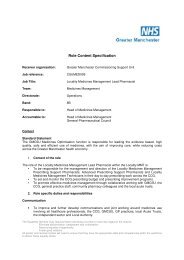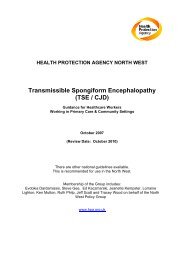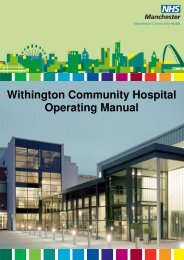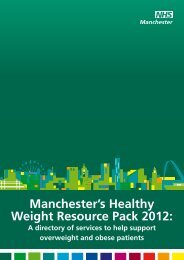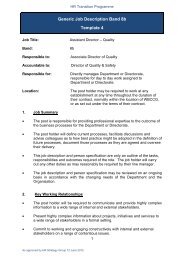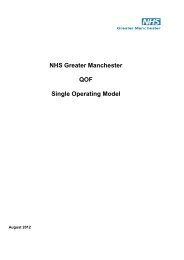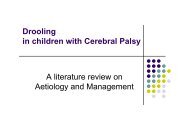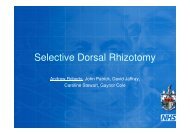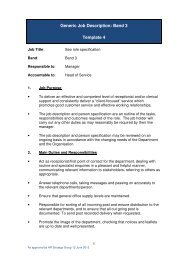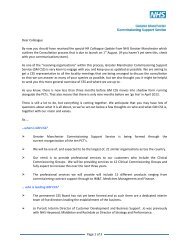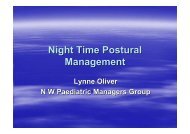clean
clean
clean
Create successful ePaper yourself
Turn your PDF publications into a flip-book with our unique Google optimized e-Paper software.
Cleaning Standards Hygiene<br />
• Access up to date National Guidance on Cleaning Standards in<br />
Healthcare<br />
• Develop a comprehensive <strong>clean</strong>ing plan and schedules<br />
• Identify colour coded <strong>clean</strong>ing equipment and products to be used in<br />
healthcare and describe effective <strong>clean</strong>ing and storage of equipment<br />
• Monitor standards of <strong>clean</strong>liness in Primary Care Dental Practices<br />
Beverly Lamb<br />
Specialist Dental Infection Control Nurse
Cleanliness in Dental Practices<br />
Achieving and maintaining high standards of <strong>clean</strong>liness<br />
in dental practices is important for three reasons:-<br />
• Because it is what patients expect and deserve;<br />
• Because it contributes to ensuring a safe environment for<br />
care;<br />
• Because it is a mandatory requirement under the Health and<br />
Social Care Act<br />
“Provide and maintain a <strong>clean</strong> and appropriate<br />
environment in managed premises that facilitates<br />
the prevention and control of infections.” (Health<br />
and Social Care Act 2008 Code of Practice<br />
criterion 2)
The essence of good <strong>clean</strong>ing is that things not only<br />
look <strong>clean</strong> they ARE <strong>clean</strong><br />
Overall the environment should be <strong>clean</strong>, dry, well lit and<br />
well ventilated.
Environmental Design<br />
All surfaces should be such as to aid successful <strong>clean</strong>ing &<br />
hygiene.<br />
• Keep lines simple and <strong>clean</strong> without unnecessary ornamentation<br />
(clutter)<br />
• Wherever possible, surfaces (including walls) should be impervious,<br />
continuous and free from damage and abrasion. They should be<br />
free from dust and visible dirt.<br />
• Notices should be laminated<br />
• Surfaces, fixtures and fittings should be easily accessed for <strong>clean</strong>ing<br />
• Modular furniture that is not easily moved should be on raised<br />
platforms to achieve a 300mm clearance from the floor to allow for<br />
<strong>clean</strong>ing
Environmental Design<br />
• Work surfaces and floor coverings should be continuous, non-slip and<br />
where possible jointless with coving to the wall<br />
• All surfaces should be free from open joints and crevices that will retain dirt<br />
particles. Unavoidable joints should be sealed with silicone<br />
• Floors or walls penetrating pipes / ducts should be sealed tightly to prevent<br />
entry of pests<br />
• Wood, unsealed joints and tiles should be avoided as these may produce<br />
reservoirs for infectious agents<br />
• Ensure good ventilation<br />
• Provide adequate hand washing facilities<br />
• Provide adequate storage facilities that are easily emptied and <strong>clean</strong>ed<br />
• Avoid open shelving and open storage<br />
• Keyboards in clinical areas should be washable or have washable covers
The Revised Healthcare Cleaning Manual is primarily aimed at the<br />
hospital sector although much of what it includes can be applied to other<br />
healthcare environments and Dental practices may find it a helpful source<br />
of advice and guidance.<br />
The National Specifications for Cleanliness are designed to help providers<br />
to meet the requirements of the CQC in relation to providing a <strong>clean</strong> and<br />
safe environment for the delivery of care.<br />
They will help to develop a system to assess the risk of’ infection and to<br />
‘maintain appropriate standards of <strong>clean</strong>liness and hygiene’<br />
http://www.nrls.npsa.nhs.uk/resources/patient-safetytopics/environment/
Policy<br />
• Identify Roles and responsibilities within the practice<br />
• Outline standards to be achieved<br />
• Detail procedure for risk assessment – identification of frequencies<br />
based on local risks<br />
• Detail provision, care & <strong>clean</strong>ing and storage of <strong>clean</strong>ing equipment.<br />
– detail on colour coding<br />
• Detail products used, correct use (dilution) storage and disposal<br />
• Develop Schedules to demonstrate all areas of the practice are<br />
<strong>clean</strong>ed in line with local risk assessment, who is responsible and<br />
what products and equipment are used<br />
• Detail Monitoring process & procedure for rectifying identified<br />
shortfalls or problems<br />
• Detail provision of training for staff and records to be kept
The Specifications adopt a 6 stage approach<br />
consisting of:-<br />
• Cleaning Plan<br />
• Risk assessment<br />
• Standard setting<br />
• Frequency identification<br />
• Cleaning responsibility<br />
• Audit
“The Environment”<br />
• All rooms : kitchen, staff rooms, store rooms, dental surgeries;<br />
Reception & waiting areas<br />
• Any general horizontal surfaces (low and high level) – floors, walls,<br />
ceiling, worktops, shelving, skirting, window ledges<br />
• furniture such as tables and chairs, toys<br />
• Toilets, sinks and the items surrounding these, including, e.g. soap<br />
& paper towel dispensers, waste bins<br />
• Doors, door handles particularly those in the immediate<br />
environment<br />
• Light fittings and switches, radiators<br />
• Window fittings i.e. blinds<br />
• Kitchen equipment, fridge, microwave, cupboards
Risk Assessment - Areas<br />
High-risk functional areas<br />
Surgeries<br />
Decontamination facilities<br />
Medium / Significant Risk functional areas<br />
public thoroughfares; waiting room<br />
public toilets<br />
Low-risk functional areas<br />
Administrative areas, store rooms
Risk Assessment -Elements<br />
Low risk items / surfaces<br />
Patients and the public have little or no direct contact -<br />
unlikely to act as reservoirs of infection (may include e.g.<br />
mirrors, internal glass, fridges, microwaves).<br />
Medium risk items / surfaces<br />
Patients and the public normally have a moderate degree of<br />
direct contact - unlikely to act as reservoirs of infection (may<br />
include e.g. high and low surfaces, chairs, curtains).<br />
High Risk items / surfaces<br />
Patients and the public have extensive and frequent contact<br />
- certain to act as reservoirs of infection (may include e.g.<br />
toilets, medical & dental equipment used in patient care).
Cleaning Frequencies<br />
• Cleaning frequencies are dependent upon degree of risk<br />
attached to each item in its location and taking into<br />
account what is practicable and necessary to ensure the<br />
determined standard of <strong>clean</strong>liness is being met<br />
• Surfaces, fixtures and fittings in low risk areas are<br />
<strong>clean</strong>ed less frequently than those in high risk areas,<br />
however certain items are high risk regardless of the<br />
area they are located and frequent <strong>clean</strong>ing is advised
Responsibilities<br />
• Evidence from elsewhere suggests that it is crucial that<br />
there be no ambiguity about whose responsibility it is to<br />
<strong>clean</strong> areas/items.<br />
• Providers are therefore recommended to ensure that<br />
there is a clear framework setting out <strong>clean</strong>ing<br />
responsibility for everything which needs to be <strong>clean</strong>ed<br />
• In the majority of dental practices <strong>clean</strong>ing is undertaken<br />
by dedicated <strong>clean</strong>ers with additional <strong>clean</strong>ing<br />
responsibilities for nurses
Standard to be achieved<br />
This may be a generic standard :<br />
All parts should be visibly <strong>clean</strong>, with no blood or<br />
body substances, dust, dirt, debris, spillages or<br />
adhesive tapes.<br />
or it may be more specific to the item in question.
Schedules<br />
Schedules should demonstrate:<br />
That all areas of the practice are <strong>clean</strong>ed including all elements<br />
Frequency of <strong>clean</strong>ing for each area / element<br />
What Equipment and products are used<br />
Who is responsible<br />
The standard to be achieved<br />
Keep schedules with <strong>clean</strong>ing policy and display in each functional area
Training<br />
• Staff should be trained at induction and updated annually<br />
(or sooner if competency issues arise)<br />
• Training should cover techniques (NHS Cleaning<br />
Manual) use of products and equipment, Infection<br />
Control and Health and Safety (manual handling,<br />
COSHH, PPE, Hand Hygiene, Waste Disposal, spillage<br />
procedures)<br />
• Records of training should be kept in the practice
Monitoring<br />
A key component of any system is having arrangements in place to<br />
assess the effectiveness of the <strong>clean</strong>ing service.<br />
Regular audits should be undertaken, problems identified are<br />
recorded and actions taken to address discrepancies<br />
Frequency of audits will be dependent upon risks – high risk areas<br />
should be audited more frequently than lower risk areas<br />
Issues raised should be followed up according to their magnitude and<br />
location<br />
Responsibilities given to managers, leads, supervisors who are<br />
competent to judge what is an acceptable standard of <strong>clean</strong>liness
CRITERIA<br />
YES<br />
NO<br />
COMMENTS<br />
Is the overall appearance of the clinical environment <strong>clean</strong>, tidy and uncluttered<br />
Is the dental chair free from rips / tears<br />
Are all surfaces i.e. walls, floors, ceilings, doors, fixtures and fittings and chairs free from dust and visible dirt<br />
Work surfaces <strong>clean</strong> and free from damage<br />
Floor Clean and free from damage<br />
Are clinical areas free from free standing or ceiling mounted fans<br />
Are window fitments (ie blinds) <strong>clean</strong><br />
Cleaning schedule on display<br />
Checklist up to date<br />
Is <strong>clean</strong>ing equipment stored correctly;<br />
Stored out of clinical area<br />
Buckets inverted and dry<br />
Mops stored upright to dry<br />
Single use covers changed after every patient<br />
Are all surfaces and equipment <strong>clean</strong>ed in between patients; work surfaces, dental chair, dental light, bracket table,<br />
delivery units, spittoons, x-ray heads, external surface of aspirator and curing lamp<br />
Are all taps, drainage points, splash backs, sinks & spittoons <strong>clean</strong> and free from visible dirt<br />
Are cupboard doors and accessible high level surfaces in clinical areas <strong>clean</strong> and free from visible dirt<br />
Are radiators, shelving, inside cupboards and drawers <strong>clean</strong> and free from visible dirt
Cleaning<br />
• Cleaning is defined as the removal of accumulated deposits by<br />
washing with a neutral <strong>clean</strong>ing detergent and with thorough drying.<br />
This will reduce the numbers of organisms and remove dirt, grease and<br />
organic matter to an acceptable level.<br />
• Cleaning the environment & equipment is important and particular<br />
attention should be paid to horizontal areas and ledges where dust will<br />
gather.<br />
• Good quality disposable detergent wipes or neutral detergent, warm<br />
water and disposable colour coded cloths should be used for <strong>clean</strong>ing.
What about Disinfection<br />
• Microbes die rapidly on <strong>clean</strong>, dry surfaces, there is little advantage in<br />
the routine use of chemical disinfectants, which may kill harmless<br />
germs and allow those most likely to cause problems to flourish without<br />
opposition.<br />
• Disinfectants can have a harmful effect on the environment by<br />
damaging the surface of equipment making it difficult to <strong>clean</strong><br />
effectively.<br />
• Items in contact with mucous membranes or items that are<br />
contaminated with virulent or readily transmitted pathogens or<br />
substance i.e. saliva, blood etc. will require disinfection following<br />
<strong>clean</strong>ing<br />
• For surfaces which become contaminated with blood and other body<br />
fluids a disinfectant solution of 1000ppm available chlorine should be<br />
applied
General Principles of Cleaning<br />
• Select the correct colour-coded equipment<br />
• Wear appropriate personal protective equipment<br />
• Use correct product diluted to manufacturers instructions<br />
• Use correct technique paying attention to contact points<br />
• Comply with H&S and infection control policies<br />
– Hand hygiene<br />
– Waste<br />
– Manual handling<br />
– Electrical equipment<br />
– COSHH<br />
– Spillage procedures
Surgery Hygiene<br />
In addition to daily <strong>clean</strong>ing all areas which may become contaminated<br />
during operative procedures should be <strong>clean</strong>ed in between patients:<br />
• Local work surfaces<br />
• Dental chair<br />
• Inspection light and handles<br />
• Delivery units / dental cart<br />
• Spittoon<br />
• Aspirator<br />
• X-ray unit & Curing lamp if used<br />
In addition, all surfaces that have potentially become contaminated<br />
should be <strong>clean</strong>ed after each patient i.e. keyboards, drawer handles
Surgery Hygiene<br />
• Clean and dirty areas for the surgery should be clearly identified to<br />
reduce the risk of cross contamination.<br />
• Keep surfaces clear and avoid open shelving and storage to reduce<br />
risk of contamination with aerosols<br />
• Areas local to the dental chair could be contaminated with aerosol<br />
from 3 in 1, handpiece, scaler and disinfection of surfaces followed<br />
by <strong>clean</strong>ing is advised<br />
• Alcohol should be avoided as it binds blood and protein to stainless<br />
steel<br />
• Disposable covers can be used on light handles, chair controls,<br />
switches etc and should be changed after every patient<br />
• Appropriate use of gloves and adequate hand hygiene
Equipment<br />
• Different areas should have different equipment<br />
• Stored in dedicated area away from potential sources of<br />
contamination and out of clinical areas<br />
• Empty contents of bucket into dedicated sluice, outside drain or<br />
toilet – NOT sink<br />
• Buckets <strong>clean</strong>ed with warm water and detergent and dried after use<br />
and stored inverted<br />
• Mops stored head up and replaced or laundered weekly or sooner if<br />
visibly contaminated with bodily fluids<br />
• Cloths should be non-shedding and single use<br />
• Hoovers should contain HEPA filters. Attachment tools <strong>clean</strong>ed with<br />
detergent and warm water or detergent wipe
Download :- www.nrls.npsa.nhs.uk/<strong>clean</strong>ingspecificationsprimarycare
DEVELOP A SCHEDULE FOR A DENTAL<br />
SURGERY<br />
• What risk is this area<br />
• What colour coding is used in this area<br />
• List all elements within the area<br />
• Determine frequency for each element (dependent upon<br />
risk)<br />
• Decide who is responsible
REFERENCES<br />
The Health and Social Care Act 2008; Code of Practice on the prevention and control<br />
of infections and related guidance - Department of Health (December 2010)<br />
Health Building Note 00-09 – Infection Control in the Built Environment - Department<br />
of Health (consultation draft April 2010)<br />
HTM01-05 – Decontamination in Primary Care Dental Practices - Department of<br />
Health (April 2009)<br />
The Revised Healthcare Cleaning Manual - National Patient Safety Agency (NPSA)<br />
June 2009<br />
The National Specifications for Cleanliness in the NHS; guidance on setting and<br />
measuring performance outcomes in primary care medical and dental premises –<br />
NPSA (August 2010)
Any Questions




